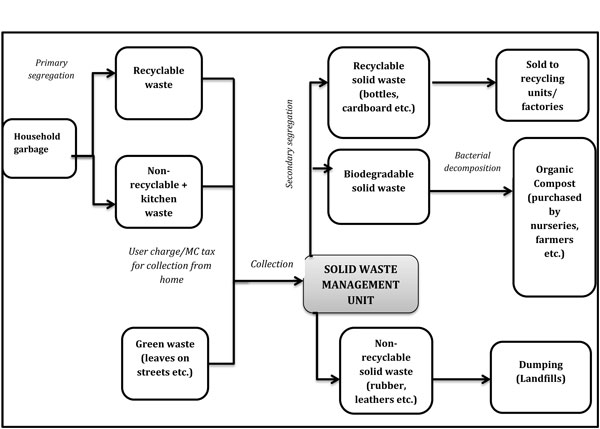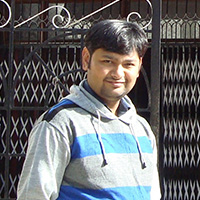Given rapid urbanisation and the increasing amounts of solid waste generated in India cities, there is a pressing need for effective waste management processes. In this article, Sourabh Bhattacharjee and Ujjwal Sinha, who have been associated with a successful waste management project in Saharanpur, provide an outline of the project and highlight lessons for other Indian cities.
Rapid urbanisation and changing lifestyles are resulting in generation of huge amounts of municipal solid waste in urban areas. According to a report of the Ministry of Urban Development, Government of India (Manual on Municipal Solid Waste Management, 2000), 100,000 metric tonnes of municipal solid waste is generated daily in India. Typically, the waste comprises a combination of kitchen waste, recyclable waste (cardboard, jute bags, polythene bags etc.) and non-recyclable waste (leather, rubber, clothes etc.), apart from the human excreta. Although recyclable waste is generally processed to produce items of value, it constitutes only a very small portion of the total waste generated. On a positive note, a large proportion of solid waste is organic (kitchen waste, leaves etc.), and can be converted into manures and compost.
The hazard
Solid waste management in urban areas is the responsibility of the Municipal Corporations (MCs). Few MCs have prepared long-term plans for effective solid waste management in their respective cities as they are constrained by the lack of adequate expertise and experience in the proper handling of solid waste.
All through India, the collection and processing capacity for solid waste falls short of the quantity generated. The collection and processing capacity is influenced by multiple factors such as infrastructural facilities, availability of skilled manpower and land, and above all, political and administrative will for efficient waste management.
In several small cities and towns, the waste collection efficiency is only about 50%1, giving rise to unsanitary conditions and diseases, especially among the urban poor who constitute approximately 35% of the country’s urban population. It is estimated that Urban Local Bodies spend about Rs. 500 to Rs. 1500 per tonne of solid waste for collection, transportation, treatment and disposal. Out of this, about 60-70% is spent on street sweeping, 20-30% on transportation, and less than 5% on final disposal, which shows that hardly any attention is given to scientific and safe disposal of waste.
When solid waste is disposed of on land in open dumps or in improperly designed landfills2 (for example, in low-lying areas that are closer to the water table/ water sources), it can cause harm in several ways:
- Ground water contamination by the leachate3 generated from the waste dump
- Surface water contamination by the water coming out of the waste dump
- Bad odour, pests, rodents and wind-blown litter in and around the waste dump
- Generation of inflammable gas (for example, methane), which may cause fires within the waste dump
- Bird menace above the waste dump which may affect passage of aircrafts
- Epidemics through stray animals
- Acidity caused in the surrounding soil
- Release of greenhouse gases from the waste dump
A solution
Effective solid waste management systems are needed to ensure better human health and safety. They must be safe for the workers as well as safeguard public health by preventing the spread of the disease. In addition, they need to be both environmentally and economically sustainable. Figure 1 below outlines a basic model of effective solid waste management.
Figure 1. Solid waste management process

Success in Saharanpur
There are nearly 125,000 households in Saharanpur in the state of Uttar Pradesh and approximately 65 tonnes of waste is generated daily. In order to dispose of household waste in a safe and cost-effective manner, ITC Ltd. launched the Mission Sunhera Kal in October 2006, under its social development initiative. The project has developed a model that reduces the burden of land filling, and helps in recycling/ reusing of biodegradable and recyclable waste. It is implemented in collaboration with an NGO (non-governmental organisation) called Muskan Jyoti Samiti (MSK).
The programme covers nearly 17,000 households in Saharanpur. The model is one of door-to-door collection of waste4, six days a week. Each waste collector covers 225-250 households daily, between 7.30 am and 1.30 pm. They move around in a rickshaw trolley, carrying two plastic bags – one for recyclable waste and the other for biodegradable and non-recyclable waste5. Thus, primary segregation of the waste is done at the household level. Households are made aware of the importance and process of primary segregation through campaigns such as road shows, pamphlets etc., as well as day-to-day reminders by waste collectors.
To separate the non-recyclable and biodegradable waste, secondary segregation is done at the waste management site. The biodegradable waste is then processed to make organic compost, the recyclable waste is sold to private vendors, and non-recyclable waste is transported to landfills. Therefore, nearly 85% of the total waste is recycled or reused and only 15% (non-recyclable) goes to landfills.
Figure 2. ITC Ltd.’s waste management initiative in Saharanpur

Working on the principle of ‘treatment closer to the generator’ or decentralised waste management system, two pieces of land have been provided by the MC for waste management. These sites have been developed close to the collection points to reduce the large expenditure on transportation.
The organic compost (‘GROWTHx’) produced is sold at Rs. 4-7 per kg depending on the packaging. Similarly, about 25,000 kg of recyclable waste is sold to vendors per month6.
Apart from the sale of by-products, the programme is funded by charging households a monthly user fee of Rs. 20-30 for the waste-collection services provided to them7.
The ITC-MSK team organises capability-building workshop for workers in the programme on a regular basis. The themes range from occupational health and safety to financial planning and cooperatives8 so that the sweepers and waste collectors can face challenges arising both on-the-job and outside work with confidence. The sessions are conducted by managers of ITC Ltd. Saharanpur, medical officers, experts from cooperatives, financial institutions etc. Moreover, to spread awareness on the issue of environmental degradation and inculcate a sense of responsibility among citizens, awareness programmes, rallies etc. are organised in schools, marketplaces, community centres etc.
Figure 3. Spreading awareness regarding environmental degradation

After nearly seven years of the launch of Mission Sunhera Kal, there are many visible changes and benefits. Since October 2006, nearly 1,200 metric tonnes of manure has been produced. The organic compost produced (‘GROWTHx’) is of very high quality and the demand generally exceeds production. Moreover, it serves as a substitute for chemical fertilisers in agriculture, hence promoting ecological sustainability. In addition, about 1,400 metric tonnes of recyclable waste (mainly plastics) has been collected and sold, which otherwise would have been strewn all over the city and choked the drains.
The programme has provided employment to nearly 75 young persons in the city through which they earn Rs. 3,000-3,500 per month. This in turn has addressed the issue of insufficient manpower to conduct door-to-door waste collection.
The collection, segregation and transportation of waste not only reduced the cost for the MC, but also its workload. The programme is being scaled up to cover the entire city, with the MC’s support. It now plays the role of a facilitator instead of the service provider.
The self-sustaining nature of the programme makes it viable in the long term. The success of this initiative lies in the fact that the elected Municipal Councillors contribute by creating awareness among people and motivating them to pay the user charges.
Moreover, it has involved the community and local government bodies by following the PPPP (people-public-private partnership) model9, ensuring the active participation of people and civil society representatives and accountability of the implementing agency in maintaining cleanliness.
Lessons for other Indian cities
‘Mission Sunhera Kal’ shows that cleanliness can be achieved in a cost-effective manner with a well-designed system for house-to-house collection of solid waste, which provides employment opportunities without putting undue financial burden on the local government body. The model is environment-friendly and economically self-sustainable, and easily replicable in cities across India.
- The PPPP9 model, involving the community, local government bodies, and other stakeholders, is a key factor in the success of the programme in Saharanpur. MCs can either implement solid waste management on their own, or outsource the process to other organisations while limiting its role to monitoring and facilitation. Community awareness regarding the importance of effective solid waste management, environmental and health hazards etc. is central to the process, so that households are willing to participate by undertaking primary segregation, and pay user chargers for waste being picked up directly from them.
- The model should be revenue-driven to make it economically sustainable in the long run. Money can be raised by either levying user charges on households, or through taxes. Sale of recyclable waste and manures are other key sources of revenue.
- MCs generally pick up waste from community bins. However, the Saharanpur model promotes picking up of waste directly from the source (households) for greater cleanliness and hygiene in the community. This would require more human resources in the form of waste collectors, in addition to the street sweepers.
Notes:
- The collection efficiency ranges between 70-90% in the major, metropolitan cities.
- A landfill site should consist of the area that will be filled up with waste, as well as additional area for support facilities. A standard landfill site should have access roads, equipment shelters, weighing scales, drainage facilities etc.
- Leachate is a liquid that is formed as water flows through waste material, extracting water-soluble compounds and particulate matter. Leachates can contain large amounts of inorganic and organic contaminants.
- The general practice followed by MCs is to collect waste from community bins, not directly from households.
- Biodegradable and non-recyclable wastes are not segregated at the household level because it is a time-consuming task and requires skill. A general list of recyclable waste is shared with households so that they are able to separate it out from biodegradable and non-recyclable wastes. From an economic point of view as well, it is important to ensure that recyclable waste is not mixed up with the rest of the waste because it has re-sale value.
- Cardboard is sold at Rs. 11 per kg and other recyclable wastes are sold at Rs. 6 per kg.
- ITC Ltd. has been supporting the project since its inception by bearing costs of human resources and other miscellaneous expenses.
- As part of the Mission, workers have been organised into a cooperative that is registered under the Cooperatives Societies Act, 2011. Through the cooperative, they can save their earnings, obtain personal loans etc. Any annual benefits/ incentives from the project are given to them through the cooperative.
- PPPs (public private partnerships) are now redefining their structure and evolving into a wider paradigm to also include ´people´ participation and community engagement. Hence, the 3Ps in the PPP framework are now transforming into the 4Ps structure: PPPPs (public-private people partnerships).




 22 April, 2015
22 April, 2015 





By: Nishant 22 May, 2020
It's really good for the knowledge. I seems that Rural waste mgt is equally important as urban sanitation.For the rural waste mgt we have to think differently it should be self sustainable as we have more numbers of village so even govt can't afford.Rural waste mgt is more important than urban because waste can make infertile to land, caused by water pollution, soil pollution, air pollution helth hazad by the mosquito and fly.